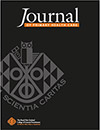HC23032 Full Text | HC23032PDF (653 KB) Open Access Article

Volume 15 Number 1 2023
HC23030 Full Text | HC23030PDF (639 KB) Open Access Article
HC22103Opportunities to be active in retirement villages and factors associated with physical activity in residents
 , Zhenqiang Wu, Annie Tatton, Joanna Hikaka
, Zhenqiang Wu, Annie Tatton, Joanna Hikaka  , Michal Boyd, Kathy Peri and Martin J. Connolly
, Michal Boyd, Kathy Peri and Martin J. Connolly
What is already known: Promotion of physical activity (PA) is essential for primary and secondary prevention of multiple health conditions across the life span. Multiple factors influence physical activity uptake in older people living in the general community. In the retirement village setting, opportunities for activity are present, potentially reducing some barriers to activity.What this study adds: Despite many opportunities to be active, many New Zealand retirement village residents are likely not meeting recommended activity levels. Several individual health and psychological factors were associated with activity, not all consistent with prior studies of community-dwelling older people. Retirement village structural factors and ownership models were associated with activity levels in residents. Clinicians should target individualised PA discussions to older adults with risk factors identified in this study such as female gender, fatigue and poor self-reported health.
HC22103 Abstract | HC22103 Full Text | HC22103PDF (738 KB) | HC22103Supplementary Material (1.1 MB) Open Access Article
HC22133Defining catchment boundaries and their populations for Aotearoa New Zealand’s rural hospitals
 , Katharina Blattner
, Katharina Blattner  , Rory Miller
, Rory Miller  , Sue Crengle, Stephen Ram, Xaviour Walker and Garry Nixon
, Sue Crengle, Stephen Ram, Xaviour Walker and Garry Nixon
What is already known: New Zealand’s rural hospitals do not fit a homogenous concept. There is no standardised description of each rural hospital’s catchment boundary and its population characteristics. What this study adds: Our study findings provide, for the first time for Aotearoa New Zealand, a standardised description of each rural hospital’s catchment boundary and the socio-demographic characteristics of the population living within this area. NZ’s rural hospitals serve very different communities.
HC22133 Abstract | HC22133 Full Text | HC22133PDF (1.2 MB) | HC22133Supplementary Material (1.9 MB) Open Access Article
What is already known: Maternal and child health provider, Whānau Āwhina Plunket, has noted inequities by deprivation level, location and ethnicity in its post-natal depression screening. What this study adds: Registered nurses working for Whānau Āwhina Plunket rated their confidence in using the postnatal depression screening tool highly; however, they did not have the same level of support for the efficacy of the tool cross-culturally. Nurses’ lack of confidence in the use of the PHQ-3 with ethnically diverse families may be negatively affecting their screening. Further work is required with Well Child Tamariki primary care services to ensure all whānau receive screening and treatment services, which consider cultural requirements as a priority.
HC22120 Abstract | HC22120 Full Text | HC22120PDF (717 KB) | HC22120Supplementary Material (727 KB) Open Access Article
What is already known: Enrolment in a general practice and uptake of screening services are lower among NZ Asians in comparison to other NZ ethnic groups. Lack of knowledge about healthcare systems is a barrier to accessing health care among migrant populations, both in New Zealand and overseas. What this study adds: Empirical data about web-based information regarding general practice services for Asian migrants in New Zealand, with a special focus on navigational health literacy. This study also provides information on barriers to understanding and navigating health care, as perceived by NZ Asians.
HC22132 Abstract | HC22132 Full Text | HC22132PDF (766 KB) Open Access Article
What is already known: Expert consensus-based explicit criteria have been developed internationally to identify potentially inappropriate medications that should be avoided or prescribed with caution for older adults due to their association with adverse outcomes. To date, no similar criteria have been published within the New Zealand healthcare setting. What this study adds: The NZ criteria are explicit criteria for older adults with polypharmacy, which is tailored to New Zealand healthcare’s unique pharmacopoeia, clinical practice, and prescribing patterns. Some potentially inappropriate medications identified in the NZ criteria were less commonly identified in internationally developed criteria.
HC22135 Abstract | HC22135 Full Text | HC22135PDF (748 KB) | HC22135Supplementary Material (740 KB) Open Access Article
HC22094Interventions designed to improve uptake of allopurinol for gout treatment in Aotearoa New Zealand: a scoping review
 , Malakai Ofanoa
, Malakai Ofanoa  , Siobhan Tu’akoi
, Siobhan Tu’akoi  , Hinamaha Lutui, Maryann Heather
, Hinamaha Lutui, Maryann Heather  , Rawiri McKree Jansen
, Rawiri McKree Jansen  , Nicola Dalbeth
, Nicola Dalbeth  , Corina Grey
, Corina Grey  and Felicity Goodyear-Smith
and Felicity Goodyear-Smith 
What is already known: Aotearoa New Zealand has one of the highest prevalences of gout in the world. Pacific and Māori people are diagnosed with gout earlier and at much higher rates; they also experience more frequent gout flares, have the highest hospital admissions and hence poorer quality of life. However, although Pacific and Māori people experience the highest burden of gout, they are less likely to receive continuous allopurinol treatment compared to non-Pacific, non-Māori people with gout. What this study adds: This scoping review provides an updated stocktake of all interventions in Aotearoa New Zealand that aim to improve the uptake of allopurinol for gout treatment, and their evaluations, where available.
HC22094 Abstract | HC22094 Full Text | HC22094PDF (980 KB) | HC22094Supplementary Material (773 KB) Open Access Article
HC22093Addressing rheumatic fever inequities in Aotearoa New Zealand: a scoping review of prevention interventions
 , Malakai Ofanoa
, Malakai Ofanoa  , Samuela Ofanoa
, Samuela Ofanoa  , Hinamaha Lutui, Maryann Heather
, Hinamaha Lutui, Maryann Heather  , Rawiri McKree Jansen
, Rawiri McKree Jansen  and Felicity Goodyear-Smith
and Felicity Goodyear-Smith 
What is already known: Although many interventions have been tried, rheumatic fever remains a significant issue in Aotearoa New Zealand, particularly for Pacific and Māori populations. What this study adds: This scoping review identified a need for more community-led interventions, particularly by and for Pacific and Māori people, that undertake rigorous evaluation processes.
HC22093 Abstract | HC22093 Full Text | HC22093PDF (960 KB) | HC22093Supplementary Material (1.6 MB) Open Access Article
HC22113Bridging the gap between primary and secondary care: a utilisation evaluation of an otolaryngology GPwSI programme
 , Nadina Thwaites, Sharon Arrol, Bruce Arroll
, Nadina Thwaites, Sharon Arrol, Bruce Arroll  , Christin Coomarasamy and Randall Morton
, Christin Coomarasamy and Randall Morton
What is already known: The NZ Health reforms aim for more integration and a seamless transition between primary and secondary health services. GPwSIs overseas have been shown to provide suitable, efficient secondary care within the primary care setting. What this study adds: This study supports one of the goals of Health NZ reforms, through a programme that provides secondary level care within the primary setting at greater convenience and no disadvantage to patients. It shows how GPwSIs can function within the context of the New Zealand health system to help improve wait times and provide suitable specialty care, often without the need for specialist intervention.
HC22113 Abstract | HC22113 Full Text | HC22113PDF (665 KB) Open Access Article
HC22117The cost savings of the rural accelerated chest pain pathway for low-risk chest pain in rural general practice: a cost minimisation analysis
 , Garry Nixon, Tim Stokes
, Garry Nixon, Tim Stokes  , Michelle Smith, John W. Pickering
, Michelle Smith, John W. Pickering  , Talis Liepins and Martin Than
, Talis Liepins and Martin Than 
What is already known: To access the current standard-of-care for chest pain assessment, patients in rural and remote areas have historically had to travel large distances to hospital emergency departments. The rural accelerated chest pain pathway that incorporates point-of-care troponin allows assessment in rural general practice and patients assessed as low-risk can remain in their communities. The comparative costs of these two assessment approaches are unknown. What this study adds: There are potential savings to both the patient and the health system when assessment for low-risk chest pain is completed in rural general practice using the rural accelerated chest pain pathway.
HC22117 Abstract | HC22117 Full Text | HC22117PDF (599 KB) | HC22117Corrigendum (599 KB) | HC22117Supplementary Material (989 KB) Open Access Article
HC22117_COCorrigendum to: The cost savings of the rural accelerated chest pain pathway for low-risk chest pain in rural general practice: a cost minimisation analysis
HC22117_CO Abstract | HC22117_COCorrigendum (678 KB) Open Access Article
What is already known: Long-term immersion in rural communities during healthcare training can increase intentions to work in rural communities. It is unknown whether short rural placements influence healthcare graduate career trajectories. What this study adds: Graduates who participated in a 5-week rural interprofessional education programme were not more likely to work in rural locations at 3 years’ post-registration than those who did not attend, but considered the programme had increased their interest and abilities to work with Māori and people from rural locations.
HC22136 Abstract | HC22136 Full Text | HC22136PDF (884 KB) | HC22136Supplementary Material (924 KB) Open Access Article
What is already known: The HealthPathways platform is widely used by general practice and junior doctors. There was no similar clinical guidance repository for allied health in Canterbury. What this study adds: Allied Healthways has been developed as part of the HealthPathways platform in Canterbury, and has demonstrated that clinical pathways are useful for patient care, change management, and education for allied health professionals.
HC22111 Abstract | HC22111 Full Text | HC22111PDF (1 MB) | HC22111Supplementary Material (1 MB) Open Access Article
HC23018 Full Text | HC23018PDF (565 KB) Open Access Article
HC23025Rural practice. The challenges and rewards of living and working in the same community
HC23025 Full Text | HC23025PDF (704 KB) Open Access Article
HC23019 Full Text | HC23019PDF (636 KB) Open Access Article



